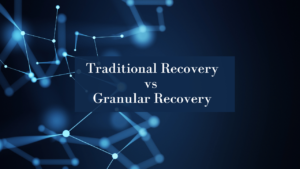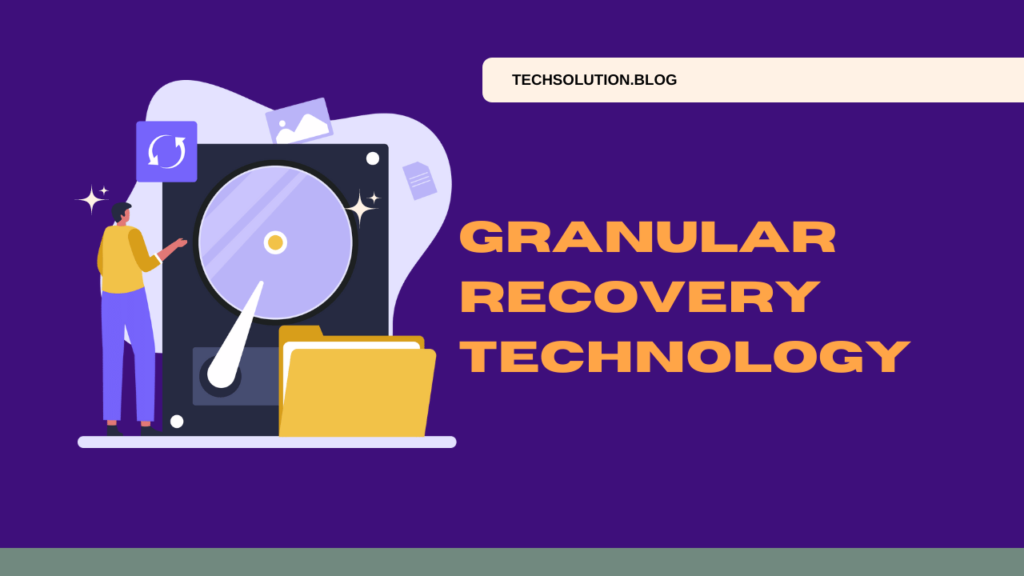Are you seeking insights into how precise data recovery can impact business efficiency and continuity? In data management and restoration, the ability to recover data elements specifically is crucial. Granular Recovery Technology (GRT) stands out in this area, providing detailed and rapid data recovery capabilities.
This article explores the enhancements Granular Recovery Technology brings to data restoration, discussing its mechanisms, applications, and benefits.
What is Granular Recovery Technology?
Granular Recovery Technology (GRT) is a sophisticated feature used in data backup and recovery systems that allows for the precise restoration of individual elements from a larger data set. Unlike traditional recovery methods that may necessitate restoring an entire database or file system to access specific items, GRT enables users to selectively recover only the items they need, such as individual files, emails, documents, or database records.
This technology works by creating detailed indexes of data during the backup process. These indexes catalog every item in the backup, allowing quick and direct access to specific data components without processing or restoring unrelated data. This granular approach speeds up the recovery process and reduces the operational impact of data recovery by minimizing downtime and resource usage.
GRT is particularly valuable in environments where data integrity and quick access to specific data are crucial, such as in financial transaction databases or corporate settings where email communications hold critical operational data. By providing a means to quickly restore exactly what is needed, GRT enhances both efficiency and data management practices within organizations.
Applications of Granular Recovery Technology

Granular Recovery Technology (GRT) has a wide range of applications across various sectors, significantly enhancing data management and recovery processes.
Here are some of the key applications of GRT:
Email Recovery
GRT is extremely useful in environments that manage large volumes of emails, such as corporate offices or service providers. It allows for the recovery of individual emails, attachments, and even specific components within an email application, such as contacts and calendar entries. This capability is crucial when specific information needs to be restored quickly without needing a full system recovery.
Database Management
In database systems, GRT enables the recovery of specific rows, tables, or transactions without restoring the entire database. This is particularly beneficial in sectors like banking and e-commerce, where transaction integrity and quick data recovery are essential. Granular recovery helps maintain continuity in operations and minimizes downtime during data restoration processes.
File Systems and Documents
For organizations that handle a significant amount of digital documents, GRT allows the restoration of individual files or folders from a complex file system. This is useful in scenarios where accidental deletion or corruption occurs, as only the affected files must be restored, preserving the rest of the system’s integrity and functionality.
Virtualized Environments
GRT also benefits virtualized environments where virtual machines (VMs) host critical applications and services. It allows for the recovery of individual VM files or specific data within a VM, facilitating more efficient management and reducing the impact of data loss on overall system performance.
Content Management Systems (CMS)
In CMS platforms, you can use GRT to recover specific content items, such as articles, media files, or user data, without rolling back the entire content database. This is especially useful for media companies and digital publishers who need to quickly restore content integrity in the event of data issues.
Enterprise Applications
Many enterprise applications like CRM and ERP systems benefit from GRT because it can restore specific data entries. For example, if a critical customer record or a financial entry is lost or corrupted, GRT allows for the recovery of just that data without affecting the broader system operations.
Legal and Compliance
In industries like healthcare, legal services, and finance, where compliance and legal hold requirements demand precise data retrieval, GRT ensures the recovery and presentation of specific documents or records without compromising other sensitive data.
Pros and Cons of Granular Recovery Technology
Granular Recovery Technology (GRT) offers a sophisticated data backup and recovery approach that allows for the selective restoration of individual data elements. Like any technology, GRT has its own advantages and challenges.
Below, we explore the pros and cons of implementing Granular Recovery Technology:
Pros of Granular Recovery Technology |
Cons of Granular Recovery Technology |
| Precision in Data Recovery: GRT allows for the precise recovery of specific files, emails, documents, or database entries without restoring entire systems. | Complexity in Setup and Management: Implementing GRT can be complex and might require sophisticated backup software and configurations, necessitating skilled IT personnel. |
| Reduced Recovery Time: Restoring only necessary data elements makes recovery much faster than traditional methods, reducing operational disruptions. | Higher Initial Costs: Initial setup for a granular recovery system, including software acquisition and configuration, can be more expensive than traditional backup solutions. |
| Efficient Use of Storage: Supports incremental backups that only store changes, significantly reducing the storage space required and lowering storage costs. | Potential for Incomplete Backups: If not properly configured, there’s a risk of incomplete backups, which can complicate or prevent effective data recovery. |
| Enhanced Flexibility: Users can recover data from any point in time available within the backup, offering the flexibility to revert to the exact moment before data issues occur. | Software Dependency: The success of granular recovery often depends on specific backup software, which can pose risks if the software becomes obsolete or unsupported. |
Traditional Recovery vs Granular Recovery: What’s the Difference?

The methods used for data backup and recovery can significantly impact the process’s efficiency and effectiveness. Traditional recovery and Granular Recovery Technology (GRT) are two distinct approaches, each with its characteristics and applications.
Understanding the differences between these two can help organizations choose the most suitable method for their needs.
Traditional Recovery
Traditional recovery generally involves restoring entire systems, databases, or large data sets from a backup. This method does not discriminate between components; it restores everything backed up at a certain time.
- Bulk Restoration: Restores entire data blocks, systems, or databases regardless of the specific data needed.
- Simplicity: Generally simpler to set up and manage, as it does not require detailed indexing of individual data items.
- Time-Consuming: Restoring large volumes of data can be time-consuming, especially if the needed information is a small part of the overall backup.
- Comprehensive: Useful when the entire system needs to be rolled back to a previous state, such as after a catastrophic system failure.
Granular Recovery
Granular Recovery Technology allows for the recovery of specific files, folders, emails, database entries, or other individual data components without restoring a complete backup.
- Selective Recovery: Enables precise targeting of specific data elements for recovery, which can drastically reduce the time and resources needed.
- Complex Setup: Requires a more complex setup involving detailed indexing and management to allow for individual data item recovery.
- Efficiency: Reduces downtime by allowing users to quickly access and restore only the necessary data.
- Storage and Cost Efficiency: Often more storage-efficient because it can integrate with incremental backup techniques that store only changes since the last full backup.
Comparative Overview
| Aspect | Traditional Recovery | Granular Recovery |
|---|---|---|
| Scope of Recovery | Whole system or large data blocks | Specific files, emails, database rows, etc. |
| Complexity | Lower complexity, easier to implement | Higher complexity requires detailed configuration |
| Recovery Speed | Slower, as larger volumes of data are involved | Faster, as only selected data needs to be processed |
| Flexibility | Less flexible, as it does not allow for partial restoration | Highly flexible, allows for restoration of specific elements |
| Use Case | Best suited for complete system recoveries after major failures | Ideal for targeted data recovery and minimizing operational disruptions |
Understanding these differences is crucial for businesses as they design their data recovery strategies. Traditional recovery might suffice for some scenarios, especially when restoring entire systems to a previous state. In contrast, Granular Recovery Technology better suits environments where time is critical and only specific data needs recovery, offering a more efficient and targeted approach to data management.
Final Thought
Granular Recovery Technology offers considerable advantages in terms of precision, speed, and storage efficiency; it also presents challenges such as complexity and higher initial investment. Organizations considering GRT should weigh these factors carefully against their specific needs, resources, and capacity for managing advanced IT solutions. The decision to implement GRT should be informed by a thorough analysis of both operational requirements and potential risks.
FAQs:
What is granular level recovery?
Granular-level recovery allows the restoration of individual files, emails, or database objects from a backup without restoring the entire system.
What is granular recovery technology?
Granular recovery technology enables precise recovery of specific data items, improving efficiency and reducing downtime during restoration.
What are the benefits of backup granularity?
Backup granularity enhances recovery speed, minimizes data loss, and provides flexibility in restoring only the necessary components.
What is GRT restore?
GRT (Granular Recovery Technology) restore refers to the process of recovering individual items from a backup using granular recovery capabilities.



